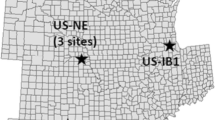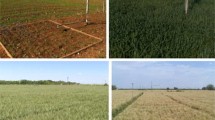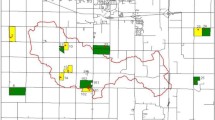Abstract
A surface energy balance model (SEB) was extended by Lagos et al. Irrig Sci 28:51–64 (2009) to estimate evapotranspiration (ET) from variable canopy cover and evaporation from residue-covered or bare soil systems. The model estimates latent, sensible, and soil heat fluxes and provides a method to partition evapotranspiration into soil/residue evaporation and plant transpiration. The objective of this work was to perform a sensitivity analysis of model parameters and evaluate the performance of the proposed model to estimate ET during the growing and non-growing season of maize (Zea Mays L.) and soybeans (Glycine max) in eastern Nebraska. Results were compared with measured data from three eddy covariance systems under irrigated and rain-fed conditions. Sensitivity analysis of model parameters showed that simulated ET was most sensitive to changes in surface canopy resistance, soil surface resistance, and residue surface resistance. Comparison between hourly estimated ET and measurements made in soybean and maize fields provided support for the validity of the surface energy balance model. For growing season’s estimates, Nash–Sutcliffe coefficients ranged from 0.81 to 0.92 and the root mean square error (RMSE) varied from 33.0 to 48.3 W m−2. After canopy closure (i.e., after leaf area index (LAI = 4) until harvest), Nash–Sutcliffe coefficients ranged from 0.86 to 0.95 and RMSE varied from 22.6 to 40.5 W m−2. Performance prior to canopy closure was less accurate. Overall, the evaluation of the SEB model during this study was satisfactory.







Similar content being viewed by others
References
Allen RG, Pereira LS, Raes D, Smith M (1998) Crop evapotranspiration: guidelines for computing crop requirement, irrigation and drainage paper no. 56. Irrigation and drainage paper no 56. FAO, Rome
Allen RG, Tasumi M, Trezza R (2007) Satellite-based energy balance for mapping evapotranspiration with internalized calibration (METRIC)-model. J Irrig Drain Eng 133(4):380–394
Alves I, Cameira M (2002) Evapotranspiration estimation performance of root zone water quality model: evaluation and improvement. Agric Water Manag 57:61–73
Alves I, Pereira LS (2000) Modeling surface resistance from climatic variables? Agric Water Manag 42:371–385
Anadranistakis M, Liakatas A, Kerkides P, Rizos S, Gavanosis J, Poulovassilis A (2000) Crop water requirements model tested for crops grown in Greece. Agric Water Manag 45:297–316
ASCE (2002) The ASCE standardized equation for calculating reference evapotranspiration, task committee report. Environment and Water Resources Institute of ASCE, New York
Choudhury BJ, Monteith JL (1988) A four layer model for the heat budget of homogeneous land surfaces. Q J R Meteorol Soc 114:373–398
Coffey ME, Workman SR, Taraba JL, Fogle AW (2004) Statistical procedures for evaluating daily and monthly hydrologic model predictions. Trans ASAE 47:59–68
Domingo F, Villagarcía L, Brenner AJ, Puigdefábregas J (1999) Evapotranspiration model for semi-arid shrub-lands tested against data from Spain. Agric For Meteorol 95:67–84
Farahani HJ, Ahuja LR (1996) Evapotranspiration modeling of partial canopy/residue covered fields. Trans ASAE 39:2051–2064
Farahani HJ, Bausch W (1995) Performance of evapotranspiration models for Maize—bare soil to closed canopy. Trans ASAE 38:1049–1059
Flores H (2007) Penman–Monteith formulation for direct estimation of maize evapotranspiration in well watered conditions with full canopy. PhD Dissertation, University of Nebraska-Lincoln
Gardiol JM, Serio LA, Della Maggiora AI (2003) Modelling evapotranspiration of corn (Zea mays) under different plant densities. J Hydrol 271:188–196
Gash JHC (1986) A note on estimating the effect of a limited fetch on micrometeorological evaporation measurements. Bound Lay Meteorol 35:409–413
Iritz Z, Tourula T, Lindroth A, Heikinheimo M (2001) Simulation of willow short-rotation forest evaporation using a modified Shuttleworth-Wallace approach. Hydrol Process 15:97–113
Irmak S, Mutiibwa D, Irmak A, Arkebauer T, Weiss A, Martin D, Eisenhauer D (2008) On the scaling up leaf stomatal resistance to canopy resistance using photosynthetic photon flux density. Agric For Meteorol 148:1034–1044
Jensen JM, Wright JL, Pratt BJ (1971) Estimating soil moisture depletion from climate, crop and soil data. Trans ASAE 14:954–959
Katerji N, Rana G (2006) Modeling evapotranspiration of six irrigated crops under Mediterranean climate conditions. Agric For Meteorol 138:142–155
Kjelgaard JF, Stockle CO (2001) Evaluating surface resistance for estimating corn and potato evapotranspiration with the Penman-Monteith model. Trans ASAE 44:797–805
Krause P, Boyle DP, Base F (2005) Comparison of different efficiency criteria for hydrological model assessment. Adv Geosci 5:89–97
Lafleur P, Rouse W (1990) Application of an energy combination model for evaporation from sparse canopies. Agric For Meteorol 49:135–153
Lagos LO, Martin D, Verma S, Suyker A, Irmak S (2009) Surface energy balance model of transpiration from variable canopy cover and evaporation from residue-covered or bare-soil systems. Irrig Sci 28:51–64
Legates DR, McCabe GJ (1999) Evaluating the use of “goodness of fit” measures in hydrologic and hydro climatic model validation. Water Resour Res 35:233–241
Massman WJ (1992) A surface energy balance method to partitioning evapotranspiration data into plant and soil components for a surface with partial canopy cover. Water Resour Res 28:1723–1732
Meyers TP, Hollinger SE (2004) An assessment of storage terms in the surface energy balance of maize and soybean. Agric For Meteorol 125:105–115
Monteith JL (1965) Evaporation and the environment. Proc Symp Soc Expl Biol 19:205–234
Moriasi DN, Arnold JG, Van Liew MW, Bingner RL, Harmel RD, Veith TL (2007) Model evaluation guidelines for systematic quantification of accuracy in watershed simulations. Trans ASAE 50:885–900
Odhiambo LO, Irmak S (2011) Performance of extended Shuttleworth-Wallace model for estimating and partitioning of evapotranspiration in a partial residue-covered subsurface drip-irrigated Soybean field. Trans ASABE 54:915–930
Ortega-Farias S, Olioso A, Antonioletti R (2004) Evaluation of the Penman-Monteith model for estimating soybean evapotranspiration. Irrig Sci 23:1–9
Ortega-Farias S, Carrasco M, Olioso A (2007) Latent heat flux over Cabernet Sauvignon vineyard using the Shuttleworth and Wallace model. Irrig Sci 25:161–170
Parkes M, Jiang W, Knowles R (2005) Peak crop coefficient values for Shaanxi north-west China. Agric Water Manag 73:149–168
Poblete-Echeverría C, Ortega-Farias S (2009) Estimation of actual evapotranspiration for a drip-irrigated Merlot vineyard using a three-source model. Irri Sci 28:65–78
Rana G, Katerji N, Mastrorilli M, El Moujabber M, Brisson N (1997) Validation of a model of actual evapotranspiration for water stressed soybeans. Agric For Meteorol 86:215–224
Rana G, Katerji N, De Lorenzi F (2005) Measurement and modelling of evapotranspiration of irrigated citrus orchard under Mediterranean conditions. Agric For Meteorol 128:199–209
Schuepp PH, Leclerc MY, Macpherson JI, Desjardins RL (1990) Footprint prediction of scalar fluxes from analytical solutions of the diffusion equation. Bound Lay Meteorol 50:355–373
Shuttleworth WJ (2006) Towards one-step estimation of crop water requirements. Trans ASAE 49:925–935
Shuttleworth WJ, Gurney R (1990) The theoretical relationship between foliage temperature and canopy resistance in sparse crops. Q J R Meteorol Soc 116:497–519
Shuttleworth WJ, Wallace JS (1985) Evaporation from sparse crops-an energy combination theory. Q J R Meteorol Soc 111:839–855
Stannard DI (1993) Comparison of Penman-Monteith, Shuttleworth-Wallace, and modified Priestley-Taylor evapotranspiration models for wildland vegetation in semiarid rangeland. Water Resour Res 29:1379–1392
Suyker A, Verma S (1993) Eddy correlation measurements of CO2 flux using closed path sensor: theory and field test against open path sensor. Bound Lay Meteorol 64:391–407
Suyker A, Verma S (2008) Interannual water vapor and energy exchange in an irrigated Maize-based agroecosystem. Agric For Meteorol 148:417–427
Suyker A, Verma S (2009) Evapotranspiration of irrigated and rain fed maize-soybean cropping systems. Agric For Meteorol 149:443–452
Tourula T, Heikinheimo M (1998) Modeling evapotranspiration from a barley field over the growing season. Agric For Meteorol 91:237–250
Verma S, Dobermann A, Cassman KG, Walters DT, Knops JM, Arkebauer TJ, Suyker A, Burba G, Amos B, Yang HS, Ginting D, Hubbard KG, Gitelson AA, Walter-Shea EA (2005) Annual Carbon dioxide exchange in irrigated and rain fed maize-based agroecosystems. Agric Forest Meteorol 131:77–96
Acknowledgments
This project was partially supported by funding from the US EPA, the University of Nebraska Program of Excellence and the University of Nebraska-Lincoln Institute of Agriculture and Natural Resources, Fondo de Fomento al Desarrollo Cientifico y Tecnologico (FONDEF D09I1146), and Fondo Nacional de Desarrollo Cientifico y Tecnologico (FONDECYT 11100083). Their support is gratefully recognized.
Author information
Authors and Affiliations
Corresponding author
Additional information
Communicated by S. Ortega-Farias.
Rights and permissions
About this article
Cite this article
Lagos, L.O., Martin, D.L., Verma, S.B. et al. Surface energy balance model of transpiration from variable canopy cover and evaporation from residue-covered or bare soil systems: model evaluation. Irrig Sci 31, 135–150 (2013). https://doi.org/10.1007/s00271-011-0298-9
Received:
Accepted:
Published:
Issue Date:
DOI: https://doi.org/10.1007/s00271-011-0298-9




